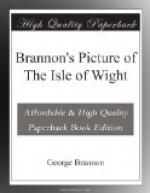* * * * *
ST. LAWRENCE.
>>_The_ CHURCH, here, is from its diminutiveness, quite an object of curiosity; and the stranger will also notice THE WELL, on the road-side; but the VILLA and COTTAGE are both secluded from public view.
* * * * *
“Here lawns, and groves,
and op’ning prospects break
With sweet surprize upon the
wand’ring eye:—
While through romantic scenes
and hanging woods.
And valleys green, and rocks,
and hollow dales,
We rove enchanted.”
The scenery of St. Lawrence is a singular union of the cultivated with the wild and romantic—a pleasing interchange of the elegance of splendid retirement with the unobtrusive dwellings of laboring peasants, scattered amidst sheltering groves and ivy-covered rocks. Here the Rt. Hon. Earl Yarborough has ...
“A country-cottage—near
a chrystal flood,
A winding valley, and a lofty
wood;”
Long celebrated as the favorite retreat of the late Sir Richard Worsley, of Appuldurcombe Park, who embellished it in quite a classical style—planting a vineyard, decorating the grounds with models of ancient temples, &c. The house has since been considerably enlarged, and ornamented in the old-English style with elaborate barge-boards and pinnacles. At a short distance is the recently built residence of his Lordship’s brother, the Hon. Capt. C.D. Pelham, R.N.—also in the Elizabethan style. By way of contradistinction, the original is emphatically called the Villa, and the latter, the Cottage. It is much to be regretted, that the public have of late been altogether excluded from the grounds—from even walking on the edge of the sea-cliffs!
[Illustration: ST LAWRENCE CHURCH UNDERCLIFF ISLE OF WIGHT]
The miniature CHURCH seldom fails of proving an amusing object with every visitor,—for it ranks among the smallest parochial places of religious worship in Great Britain: its belfry, the pretty little porch, and its several windows, are all in character; it has however lately been found necessary to lengthen the building, in consequence of the increase of population in the vicinity.
[Illustration: ST LAWRENCE.—The WELL near the Marine Villa of the Right Honourable Lord Yarborough.—Isle of Wight.]
THE WELL encloses a fountain of ever-running crystal water, the soft murmurs of which combine with the surrounding scene to produce the most agreeable feelings; and it is marked by so much of that beautiful simplicity which is the foundation of picturesque effect, that perhaps no other object in its charming neighbourhood, except the little church, will afford the stranger more immediate pleasure.




